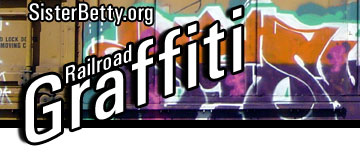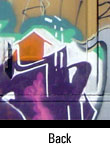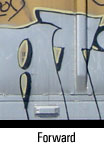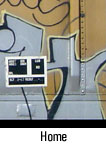| My tiny hometown is bisected by railroad tracks.
Every Sunday I prayed for a long freight train to block the street to our
dismal and hateful church. I counted the passing freight cars, noting
the names of distant rail lines: Maine Central, Chessie, Norfolk
Southern, Southern Pacific, Northern Pacific, Union Pacific. With
the passing freight cars came kaleidoscopic artwork from (I believed) the
dark and gang-infested rail yards of big cities.
Railroad graffiti* is impossible to miss. A railcar
in a dark rail yard provides a valuable target for vandals. Graffiti
artists consider railcars the ultimate canvas: a moving exhibition for
talent and effort.
I dislike graffiti in cities. Unlike murals, graffiti is often
poor quality and declares the decline of a neighborhood. More frequently,
talentless and reckless taggers destroy property. Despite my Quaker
leanings, caning seems a lovely solution. My opinion of railroad
graffiti is different.
Most railroads
in the United States were built nearly a hundred years ago. Cities
and industry surrounded railroad hubs and then spread outward, often leaving
rail yards in the dirty, industrial and working class neighborhoods. Here
the presence of graffiti is less decay than distraction. Properly
planned and executed, quality graffiti becomes a permanent, nationwide,
mobile exhibit of artistic talent. In between endless cars festooned
with bold signatures,
pieces
of true quality reflect the ability of nameless artists. The largest
modern art gallery in the world is carried by steel wheels on steel rails.
I've not spoken to a railroad executive about graffiti. I suspect
graffiti creates both problem and expense for the railways. Graffiti
covers the signage on railcars and markings showing when the car was serviced
and due for inspection. Graffiti removal is expensive and requires
a car be removed from service. Perhaps this is why so many cars bear
so much artwork.
I began photographing railroad graffiti in 2003 as part of my continual
exploration of trains
and railroads.
Photographing
graffiti is more difficult than it may seem. The best graffiti is
carried by the largest railroads. Photographing artwork on a moving
train is impossible. Major rail yards are not safe for casual tourists,
are often cordoned off from the public, and now have ridiculous levels
of policing as a result of our ill-named Department of Homeland Security
(simply photographing a train from an overpass can draw the attention of
local police). A quality telephoto lens is the best tool for these
images.
* The word graffiti is a plural
noun in Italian. In English graffiti is far more common than the
singular form graffito and is mainly used as a singular noun in
much the same way data is. When the reference is to a particular inscription
(as in There was a bold graffiti on the wall), the form graffito would
be etymologically correct but might strike some readers as pedantic outside
an archaeological context. There is no substitute for the singular use
of graffiti when the word is used as a mass noun to refer to inscriptions
in general or to the related social phenomenon. - American
Heritage Dictionary
|
I organize railroad graffiti in four categories: tags,
stencils,
signatures,
and pieces.
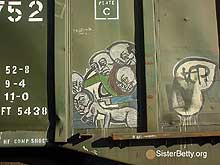
Pieces
Pieces are illustrations or especially large and intricate signatures.
The creators of pieces often consider themselves serious artists and may
plan their work long before applying it to railroad equipment.
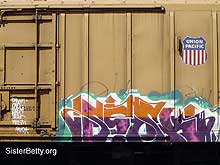 Signatures
Signatures
Signatures are large and often colorful graffiti containing a name
or a word. Signatures make up the largest portion of railroad graffiti
and often require advance planning and design.
 Stencils
Stencils
Stencil graffiti is created using a template. Several stencils
are often combined for more intricate designs. Stencils are the rarest
form of railroad graffiti
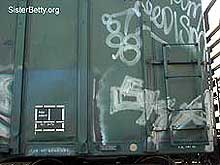
Tags
Tagging is the least creative or interesting category of railroad graffiti.
Taggers scrawl their "tags" quickly without much effort or thought.
I rarely photograph tagging as it lacks imagination, skill and talent. |
 Railroad Graffiti is a featured section of SisterBetty.org.
Explore
more here.
Railroad Graffiti is a featured section of SisterBetty.org.
Explore
more here.

The
Best Pieces
The
Best Signatures

BC
Rail
Canadian
Pacific
Santa
Fe (ATSF)
Santa
Fe Southern Railway
Union
Pacific

British
Columbia: Lillooet
Colorado:
Cañon City
Colorado:
South Fork
Idaho:
Idaho Falls
Missouri:
St. Louis
New
Mexico: Santa Fe
Ontario:
North Bay


Contact
Sister Betty
Trains
Live
Internet Camera
Road
Trip 2003
Road
Trip 2004
Stairways
of San Francisco
Click
here to purchase a print of any of Sister Betty's photographs.
High quality prints are available in sizes from 4"x6" to 36"x48".
Sister Betty's photographs have been published in several
books, newspapers and magazines. For permission to print or post
photographs from SisterBetty.org,
click
here.
Images, photographs and illustrations on SisterBetty.org
are copyrighted material.
|
